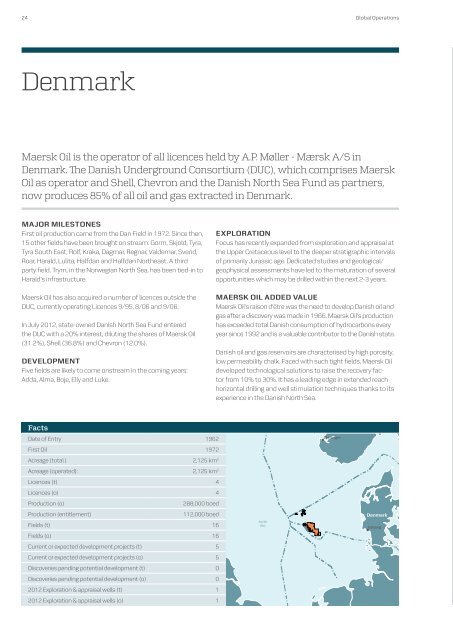Maersk Oil Company Profile
Maersk Oil Company Profile
Maersk Oil Company Profile
Create successful ePaper yourself
Turn your PDF publications into a flip-book with our unique Google optimized e-Paper software.
24 Global Operations<br />
Global Operations<br />
25<br />
Denmark<br />
<strong>Maersk</strong> <strong>Oil</strong> is the operator of all licences held by A.P. Møller - Mærsk A/S in<br />
Denmark. The Danish Underground Consortium (DUC), which comprises <strong>Maersk</strong><br />
<strong>Oil</strong> as operator and Shell, Chevron and the Danish North Sea Fund as partners,<br />
now produces 85% of all oil and gas extracted in Denmark.<br />
MajOr MilestOnes<br />
First oil production came from the Dan Field in 1972. Since then,<br />
15 other fields have been brought on stream: Gorm, Skjold, Tyra,<br />
Tyra South East, Rolf, Kraka, Dagmar, Regnar, Valdemar, Svend,<br />
Roar, Harald, Lulita, Halfdan and Halfdan Northeast. A third<br />
party field, Trym, in the Norwegian North Sea, has been tied-in to<br />
Harald’s infrastructure.<br />
<strong>Maersk</strong> <strong>Oil</strong> has also acquired a number of licences outside the<br />
DUC, currently operating Licences 9/95, 8/06 and 9/06.<br />
In July 2012, state-owned Danish North Sea Fund entered<br />
the DUC with a 20% interest, diluting the shares of <strong>Maersk</strong> <strong>Oil</strong><br />
(31.2%), Shell (36.8%) and Chevron (12.0%).<br />
develOpMent<br />
Five fields are likely to come onstream in the coming years:<br />
Adda, Alma, Boje, Elly and Luke.<br />
Facts<br />
Date of Entry 1962<br />
First <strong>Oil</strong> 1972<br />
Acreage (total ) 2,125 km 2<br />
Acreage (operated): 2,125 km 2<br />
Licences (t) 4<br />
Licences (o) 4<br />
Production (o) 288,000 boed<br />
Production (entitlement) 112,000 boed<br />
Fields (t) 16<br />
Fields (o) 16<br />
Current or expected development projects (t) 5<br />
Current or expected development projects (o) 5<br />
Discoveries pending potential development (t) 0<br />
Discoveries pending potential development (o) 0<br />
2012 Exploration & appraisal wells (t) 1<br />
2012 Exploration & appraisal wells (o) 1<br />
explOratiOn<br />
Focus has recently expanded from exploration and appraisal at<br />
the Upper Cretaceous level to the deeper stratigraphic intervals<br />
of primarily Jurassic age. Dedicated studies and geological/<br />
geophysical assessments have led to the maturation of several<br />
opportunities which may be drilled within the next 2-3 years.<br />
<strong>Maersk</strong> <strong>Oil</strong> added value<br />
<strong>Maersk</strong> <strong>Oil</strong>’s raison d’être was the need to develop Danish oil and<br />
gas after a discovery was made in 1966. <strong>Maersk</strong> <strong>Oil</strong>’s production<br />
has exceeded total Danish consumption of hydrocarbons every<br />
year since 1992 and is a valuable contributor to the Danish state.<br />
Danish oil and gas reservoirs are characterised by high porosity,<br />
low permeability chalk. Faced with such tight fields, <strong>Maersk</strong> <strong>Oil</strong><br />
developed technological solutions to raise the recovery factor<br />
from 10% to 30%. It has a leading edge in extended reach<br />
horizontal drilling and well stimulation techniques thanks to its<br />
experience in the Danish North Sea.<br />
DUC Rationalisation<br />
Since Dan, Denmark’s first field, was brought on production<br />
in 1972, more than three decades of greenfield developments<br />
have led to a peak oil rate of 350,000 barrels of oil<br />
a day in 2005. Today, production has declined to 288,000<br />
barrels of oil equivalent a day (boed), emphasising the need<br />
for a change from greenfield to brownfield management.<br />
The Danish Underground Consortium (DUC) has three<br />
main hubs: Tyra, Gorm and Dan/Halfdan. An initial study<br />
of the facilities identified that the value for the remaining<br />
assets would be maximised by a step-wise reduction of<br />
systems in operation with the objective of keeping operating<br />
expenditures and lifting costs to a minimum. However,<br />
there is always a tension between decommissioning of<br />
equipment and the impact on possible near field developments<br />
and optimisations.<br />
Following this overall study, a DUC Rationalisation Task<br />
Force was established. The focus was initially on the Tyra<br />
First <strong>Oil</strong><br />
1972<br />
predominantly gas processing hub, where it was decided to<br />
de-man the Tyra East processing complex including decommissioning<br />
of the majority of the gas processing facilities<br />
and utilising those located on Tyra West. Structural improvements<br />
at both Tyra East and West are also required. A second<br />
stage of the study work concluded that re-configuring the<br />
existing, as well as installing new, wellhead compression<br />
units would allow for higher production rates.<br />
The major offshore activities of the Tyra Rationalisation<br />
Project are expected to be completed in 2016. The Dan complex<br />
is currently under investigation with the Gorm complex<br />
to be the final processing hub to be addressed. It is envisaged<br />
that continuous review of further options for decommissioning<br />
will be part of <strong>Maersk</strong> <strong>Oil</strong>’s goal of being a ’second to none<br />
mature field operator’.








